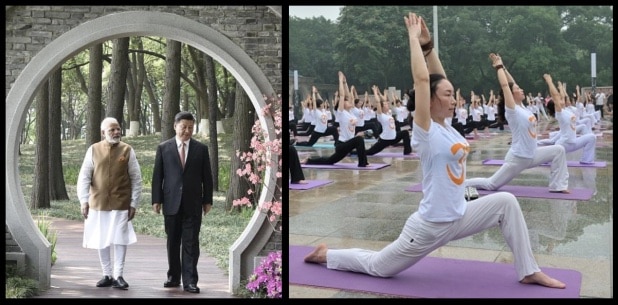Four years ago, I wrote an article explaining how there were ulterior motives behind the U.S. allowing Indians to become CEO’s of big American corporations. Now, India has gone further down that path and has almost definitely sealed its fate as a satellite of the U.S. The consequence will be that India will be stuck in the middle-income trap forever and won’t have much sovereignty in the spheres of economics or foreign policy.
Geopolitics 101
Let me explain the basics of geopolitics. A superpower like the U.S. maintains its status by keeping all the potential rivals weak. Here’s a chart of how the U.S. would like the world to look like:
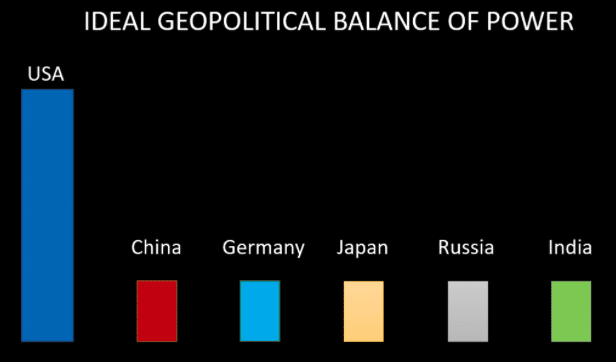
When one of the rivals gets a bit too strong, it will be attacked mercilessly. For example, by 2012, Russia’s GDP had grown 1000% in a decade. Immediately, the U.S. created problems in Ukraine, brought down the price of oil, attacked Ruble and destroyed half its value, and has been imposing sanctions on Russia ever since. Also, by creating frictions between Russia and Germany, the U.S. kills two birds in one stone–keeping two competitors down at the same time. (Just like how India-China conflicts will be America’s wet dream).
In the 1980s, Japan came under severe attack after Japanese cars and semiconductors started challenging the U.S. Every propaganda that’s used against China now was used against Japan. Result? Plaza Accord, which killed the Japanese semiconductor sector, forced Yen to double in value, blackmailed Japanese auto companies into moving manufacturing to the U.S., and basically forced Japan to commit suicide. Japan never recovered.

U.S. Congressmen breaking the evil Toshiba boombox. Time to contain Japan!
This is why Chinese leaders always said, “Hide your strength and bide your time.” But when ZTE announced world’s first 5G call in February 2018, the U.S. imposed sanctions on ZTE within two months, forced the company to pay big fines, and accept American supervisors. Similar attacks on Huawei, dozens of other successful Chinese hi-tech companies, and on entire China has been going on since 2017. Why? China today has grown a bit too much:
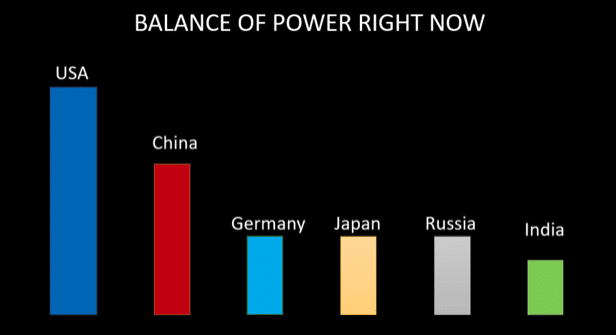
In purchasing power, China surpassed the U.S. in 2014. And, as I show in my blog post, China will very likely be the largest economy by nominal GDP within five years (by 2025) as well. Thanks to the extraordinary screw up in handling the coronavirus pandemic, the U.S. may actually lose its #1 spot by 2025. Hence all the anti-China hysteria.
How India was Recruited and Groomed
In the war against China, the U.S. has chosen India to be the big pawn, as traditional U.S. “allies” like Japan, South Korea, Philippines, Thailand, Malaysia have all signaled that they don’t want to be a part of WW3. To give credit to the U.S., they have been planning on recruiting India for a long time. Let’s expound on this more …
First, one must understand the Faustian bargain that India made with the U.S. America opened up its job market for Indians, and India opened up its entire economy for the US! And the USA wins in both sides of the deal. Get the brightest workers from India; and in return get two things: (1) access to 1.3 billion consumers, and (2) a geopolitical puppet state.
Democracy and Free Market are propaganda slogans. Why hasn’t the U.S. tried to spread democracy in Saudi Arabia? No, that would be very dangerous–what if a populist Saudi guy gets elected and kicks out the U.S. military base and starts selling oil in Yuan? That would be the end of USA’s global hegemony.
Throughout the Cold War history, the U.S. supported and installed dozens of dictators and mass murderers all over the world–in Cambodia, Indonesia, South Korea, Taiwan, all over Latin America, Middle East, Africa etc. Currently, the U.S. funds and arms about 70% of all non-democratic governments around the world. Just last year, when the socialist leader of Bolivia won the election, the U.S. instigated a military coup and overthrew the winner. In the 1970s, the U.S. even staged a coup in Australia and overthrew the popular Prime Minister who wasn’t very pro-U.S. Here is the general idea: “You can choose anyone democratically, as long as he is pro-USA.”
Thus, India shouldn’t fall for the propaganda for “like-minded democratic nations” getting together to contain China.
And “free market” was great until China started to win. Now the U.S. likes protectionism and hates WTO, which the U.S. created! When Walmart buys FlipKart–India’s successful e-commerce startup–that’s cheered on as free market. But do you think the U.S. would have allowed FlipKart to buy Walmart? Of course, not.
The Indian executives in America will never be able to go back to India and start competing corporations. The U.S. has made sure that it has enough control over Indian banks, VC’s and other financial structures to guarantee that there won’t be any funding for Indian versions of Intel, Microsoft, Cisco, Google, Facebook, Amazon etc.
China has Alibaba, Huawei, Tencent, TikTok, Baidu, BeiDou, SMIC, Xiaomi etc. to compete with every large American/European firm. India has no such indigenous players. And given the recent moves, India will never have such domestic giants.
Totally Different Success Stories for China and India
Compare India to China, which competes with the U.S. for the global market in all areas of technology, commerce, finance etc. There are 7 Indian companies in the Global Fortune 500 list; and there are 120 mainland Chinese companies on that list! India–7; China–120.
China beats India in every metric–GDP-per-capita (5x), international patents (28x), Unicorns (7x), foreign exchange reserves (6x), manufacturing output (10x), foreign trade (6x), electricity generation (4.5x), installed solar capacity (6x–38GW versus 240 GW), government spending (8x), R&D spending (20x), rice yield per hectare (2x), median wealth of an adult (13x), e-commerce market (20x), mobile internet speed (9x), bullet trains (39,000 Km in China versus zero in India), life expectancy (77 versus 69), healthcare (world ranking: China—48, India—145) and the list goes on.
In emerging technologies–5G, AI, blockchain, robotics, IoT etc.–and foundational technologies such as semiconductor chips, there’s just no comparison at all between China and India. (All the capable Indians in these fields are in the US).
You know where India beats China? In all the WRONG statistics:
- Child mortality rate: India = 4x China
- Adult Illiteracy rate: India = 8x China
- Poverty rate: India = 20x China
- Homicide/Murder rate: India = 5x China
Keep in mind that, in 1991, India and China were at pretty much the same level for all those metrics.
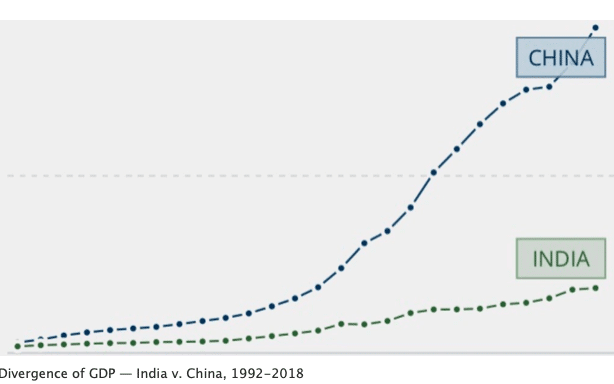
What changed? Well, India and China both opened up to the world, but in different ways. China protected its sovereignty, while India blindly embraced “reforms” and American neoliberalism. Now, it’s likely that India will turn out like any other numerous developing nations–Brazil, Mexico etc.–which will always be poorer and obedient “allies.”
To totally control a country, one must control 8 primary institutions or sectors: finance, business, media, technology, politicians, military, farming, and natural resources.

You can look at India and clearly see US’ total dominance in all these sectors. Worse, India is accelerating its vassal statehood by privatizing its state-owned banks, insurance companies, airlines, railways etc. Recently, Facebook and U.S. private equity firms like KKR bought a big chunk of Reliance Jio Platforms–the Indian telecom, digital services and e-commerce giant.
Looking at all the Indian media and the trolls on social media, it’s clear that Indians have been completely brainwashed to hate China. Indians who are so afraid of Huawei and TikTok possibly spying will gladly be 100% spied upon by Facebook, Google, Microsoft, Nokia/Ericsson and every other western tech corporation–and all of them are linked to U.S. spying agencies. This is a strategic blunder.
Has India forgotten the revelations of Edward Snowden–how the U.S. tapped Modi’s cell phone?
While it’s great that an Indian guy is the CEO of Microsoft, don’t forget that Microsoft worked with the NSA to create backdoor for Skype, Outlook etc. From Google to Facebook and Intel to Qualcomm, every U.S. hi-tech company has been proven to work with U.S. gov to enable spying. In 2020, an American company with close ties to U.S. military was revealed to have rigged 500 mobile apps to spy on hundreds of millions of people all over the world!! The PRISM program of NSA has backdoors into all the global U.S. software:
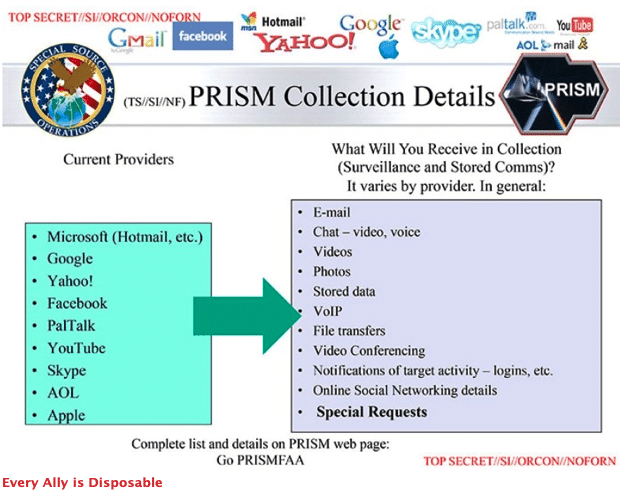
Every Ally is Disposable
What Indians forget is that how the U.S. can easily switch back and forth, turning allies into enemies or other way around. This is geopolitics and is not understood by people who get carried away with emotions of the moment. Let us take a look at some examples:
1947-1992: The U.S. supported Pakistan and often opposed India. All the jihadists in Kashmir were supplied with U.S. weapons in the 1980s. Yeah, Bin Laden was also America’s Best-Friend-Forever. After the collapse of the USSR, the U.S. swiftly dumped Pakistan and Afghanistan.

(Left) Bin Laden with Brzezinski, architect of Mujahideen and advisor to U.S. Presidents Carter and Obama. (Right) U.S. President Eisenhower visiting Pakistan
1972: To fight the USSR, the US embraced China in 1972. To woo China, the U.S. kicked Taiwan out of the permanent UN Security Council; and even told China that it could eventually take over Taiwan, the obedient vassal state!
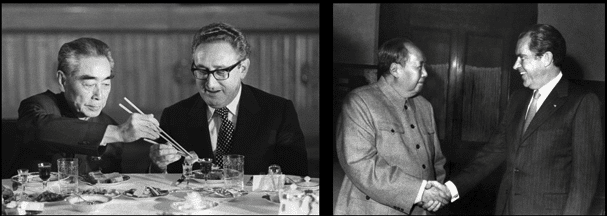
Kissinger and Pres. Nixon wooing Mao and other Chinese elites
WW2: The U.S. partnered with Russia during WW2 to defeat Hitler. At that time Stalin was America’s (temporary) best friend–later on, he was constantly demonized by the U.S. And even though Russia destroyed 70% of the Nazi military, the U.S. took all the credits for defeating Hitler. Furthermore, within a few weeks after WW2, military generals in the U.S. were seriously considering dropping nuclear bombs on Russia! (Kill your ally and take over the world!)
Hitler and Nazis: Hitler and Nazi conglomerates were funded by Wall Street and Rockefeller before WW2. Then after WW2, all the top Nazi scientists were brought to the U.S. under CIA’s covert “Operation Paperclip.” Nazi scientists got top jobs in NASA! And Nazis all over Europe were recruited by the USA to fight the Soviet Union (Operation Gladio)! Yes, it makes your head spin.
Saddam Hussein: In the 1970s and 1980s, Saddam Hussein was America’s friend and pawn to attack Iran. The U.S. actually helped Saddam build his chemical weapons, and even helped him use it against Iran. After ten years of brutal war, Saddam was demonized and targeted for regime change. (Another shocking fact is that the U.S. sold some weapons to Iran as well during the Iraq-Iran war!)
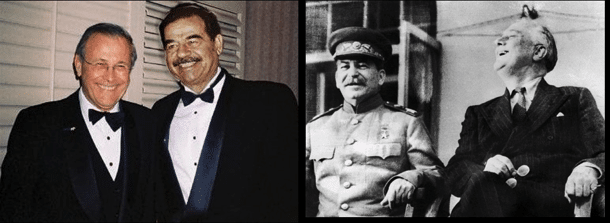
(Left) Saddam Hussein bonding with Donald Rumsfeld–architect of Iraq war later on and U.S. Sec. of Defense. (Right) U.S. President FDR having an amazing time with Stalin
Syria 2011-2020: The U.S. armed Al Qaeda, ISIS, and the Kurds to attack Assad. Anything it takes to achieve geopolitical goals. There’s no morality. As U.S. Secretary of State Pompeo boasted, “We stole, we cheated, we lied.”
The list of American Machiavellian schemes goes on. If India thinks that the American boyfriend is going to marry her and happily live ever after, Indians are too naive and don’t understand geopolitics at all.
If there’s an India-China war, not a single American is going to die for India. However, the U.S. will ensure that the proxy war continues as long as possible. This will be great business for U.S. arms dealers. Remember the words of the famous Indian activist, Arundhati Roy:
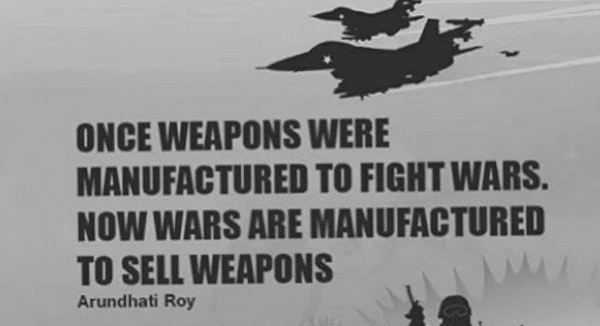
At the end of the war, India’s economy will be so weak that U.S. corporations will buy even more Indian assets for pennies on the dollar.
At the end of the war, India’s economy will be so weak that U.S. corporations will buy even more Indian assets for pennies on the dollar.
Furthermore, India must understand how the U.S. economy and even the U.S. military depends on China. American missiles and fighter jets cannot work without the rare earth minerals from China; and the U.S. economy literally cannot function for even a few months without Chinese goods and labor. Also, U.S. corporations based in China rake in tons of money, thanks to the Chinese middle class, which is the largest in the world. America’s S&P 500 companies based in China made $700 billion of revenue in 2018.
Conclusion
No, China shouldn’t be India’s enemy
First of all, China is a rising power and America is a declining power. Thus, from a practical point of view, the current Indian policy makes no sense. Most Indians are clueless about how advanced China is now. Check out my blog on China’s global leadership in technology, economy, and other areas.
India won’t catch up with China any time soon. Maybe America is blowing smoke up India’s you-know-what and feeding delusion that India can be the Asian hegemon. Even if India grows at 8-9% every year, its nominal GDP will be only $6 trillion by 2030. At that point, China will still be 5-6x larger than India and also a superpower bigger than the USA.
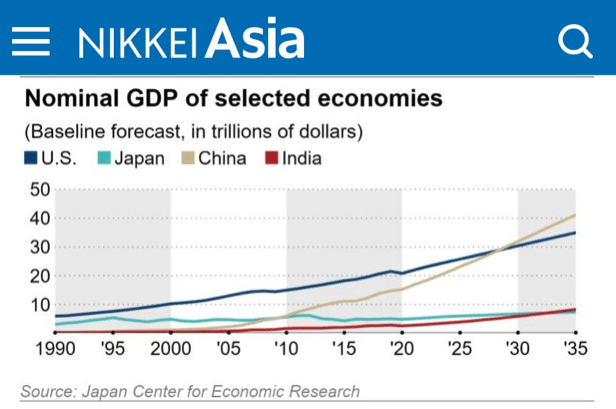
Let’s take a step back. For 2000 years, the two largest economies in the world were China and India. Guess how many wars they fought during those prosperous years? ZERO!
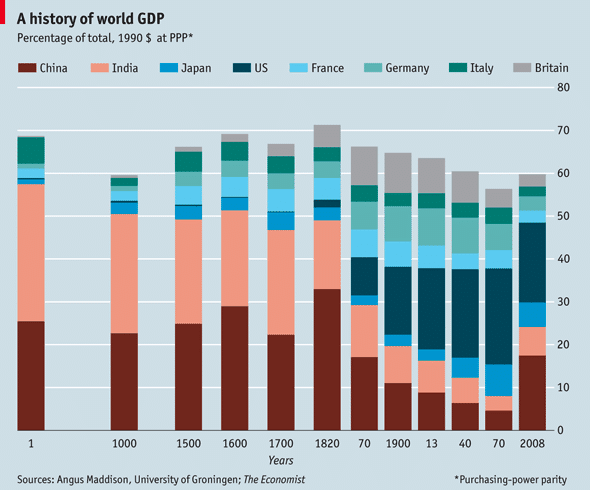
Ten years ago, there was a visionary concept called BRICS (Brazil, Russia, India, China and South Africa). What happened to it?
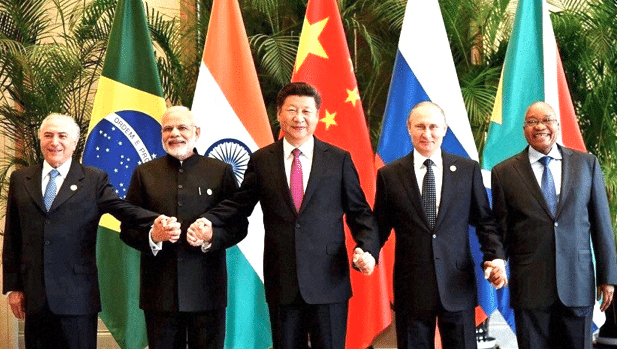
Modi, Xi Jinping and Putin at BRICS Summit
Russia and China have a 3,500 km border, and they are not at each other’s throat. Why? Because of trade, interdependence, and a win-win strategy.
A smart India will stay friends with the U.S. and, at the same time, leverage China to make peace with Pakistan. That will be the wisest and Nobel prize-deserving ingenuity. Freeze border disputes for a few years and focus on growth, trade and peace. Don’t become a victim of the divide-and-rule playbook.
Imagine if India could get cheap oil and gas from Central Asia, transported through Pakistan–that will solve India’s future energy problems. Encourage China to move some of its manufacturing to India–especially electric cars/buses, which will reduce pollution; hire China to build housing projects for tens of millions of people stuck in Indian slums; and use China’s expertise to build high-speed rail.
India should also join China’s Belt and Road Initiative, which has more than 120 countries as members, including European nations such as Italy and Greece. India can learn a lot from China–for example, how China plans 5, 10, 40 years in advance; and how China has laser-focus attention and resolute meritocracy. There are numerous areas where India and China can cooperate and also compete in healthy ways.
In 1954, Indian Prime Minister Nehru went to Beijing and spent three days with Mao. And they came up with the “Five Principles of Peaceful Coexistence.” The famous slogan in those days was, “Hindi Chini Bhai Bhai”–meaning “Indians (and) Chinese (are) Brothers.” Hopefully, sometime in the future, there will be new leadership that will try diplomacy based on those ideals.
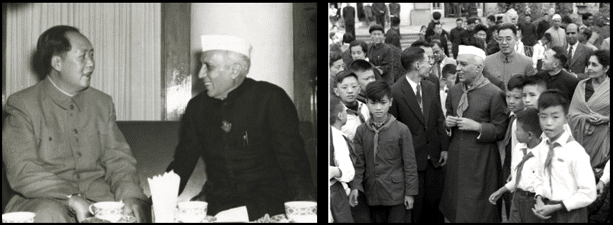
India’s global ranking in Human Development Index (HDI) is #130. That is, people in 129 countries are better off than Indians. India also has a lot of systemic and structural problems that will drag the country down, if left unsolved (see my blog). Thus, for the next twenty years or so, India’s focus should be on improving its economy, technological innovation, infrastructure, housing, healthcare, education, and environment.
As a final warning, India shouldn’t become a pawn of a disastrous war that will murder the “Asian century” in its infancy.

